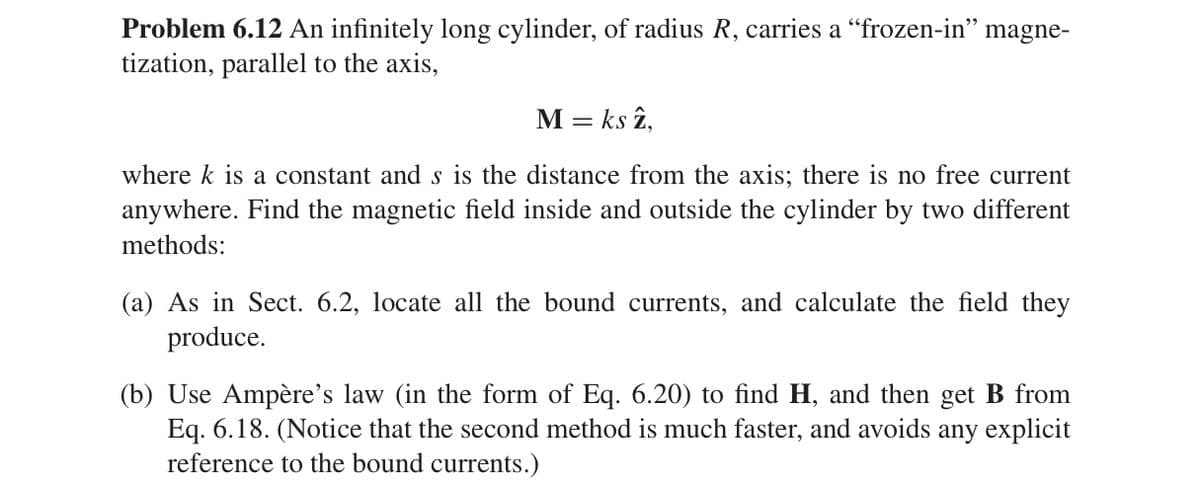Problem 6.12 An infinitely long cylinder, of radius R, carries a “frozen-in” magne- tization, parallel to the axis, M = ks z, where k is a constant and s is the distance from the axis; there is no free current anywhere. Find the magnetic field inside and outside the cylinder by two different methods: (a) As in Sect. 6.2, locate all the bound currents, and calculate the field they produce. (b) Use Ampère's law (in the form of Eq. 6.20) to find H, and then get B from Eq. 6.18. (Notice that the second method is much faster, and avoids reference to the bound currents.) any explicit
Problem 6.12 An infinitely long cylinder, of radius R, carries a “frozen-in” magne- tization, parallel to the axis, M = ks z, where k is a constant and s is the distance from the axis; there is no free current anywhere. Find the magnetic field inside and outside the cylinder by two different methods: (a) As in Sect. 6.2, locate all the bound currents, and calculate the field they produce. (b) Use Ampère's law (in the form of Eq. 6.20) to find H, and then get B from Eq. 6.18. (Notice that the second method is much faster, and avoids reference to the bound currents.) any explicit
University Physics Volume 3
17th Edition
ISBN:9781938168185
Author:William Moebs, Jeff Sanny
Publisher:William Moebs, Jeff Sanny
Chapter8: Atomic Structure
Section: Chapter Questions
Problem 49P: Show that U=B . (Hint: An infinitesimal amount of work is done to align the magnetic moment with the...
Related questions
Question

Transcribed Image Text:Problem 6.12 An infinitely long cylinder, of radius R, carries a “frozen-in” magne-
tization, parallel to the axis,
M = ks z,
where k is a constant and s is the distance from the axis; there is no free current
anywhere. Find the magnetic field inside and outside the cylinder by two different
methods:
(a) As in Sect. 6.2, locate all the bound currents, and calculate the field they
produce.
(b) Use Ampère's law (in the form of Eq. 6.20) to find H, and then get B from
Eq. 6.18. (Notice that the second method is much faster, and avoids
reference to the bound currents.)
any explicit
Expert Solution
This question has been solved!
Explore an expertly crafted, step-by-step solution for a thorough understanding of key concepts.
This is a popular solution!
Trending now
This is a popular solution!
Step by step
Solved in 2 steps with 4 images

Recommended textbooks for you

University Physics Volume 3
Physics
ISBN:
9781938168185
Author:
William Moebs, Jeff Sanny
Publisher:
OpenStax

Glencoe Physics: Principles and Problems, Student…
Physics
ISBN:
9780078807213
Author:
Paul W. Zitzewitz
Publisher:
Glencoe/McGraw-Hill

Modern Physics
Physics
ISBN:
9781111794378
Author:
Raymond A. Serway, Clement J. Moses, Curt A. Moyer
Publisher:
Cengage Learning

University Physics Volume 3
Physics
ISBN:
9781938168185
Author:
William Moebs, Jeff Sanny
Publisher:
OpenStax

Glencoe Physics: Principles and Problems, Student…
Physics
ISBN:
9780078807213
Author:
Paul W. Zitzewitz
Publisher:
Glencoe/McGraw-Hill

Modern Physics
Physics
ISBN:
9781111794378
Author:
Raymond A. Serway, Clement J. Moses, Curt A. Moyer
Publisher:
Cengage Learning
